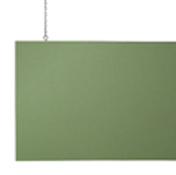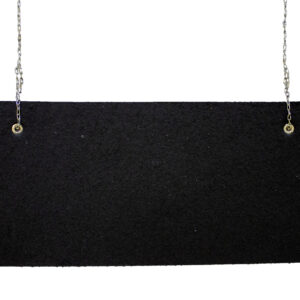Hanging Baffles
-

Udderly Quiet® Acoustic Baffle – 200 Series
Learn MoreShop Now -

Udderly Quiet® Acoustic Baffle – 250 Series
Learn MoreShop Now -

Udderly Quiet® Anechoic Hanging Baffle 3″ (Case of 5)
$551.25Shop Now -

Udderly Quiet® Class A™ Anechoic Hanging Baffle 3″ (Case of 5)
$590.25 – $792.50Shop Now -
Echo Absorber™ Hanging Baffle (Natural Blend – 1″x2’x4′)
$49.99 – $649.87Shop Now -
Echo Absorber™ Hanging Baffle (Natural Blend – 1″x4’x4′)
$68.99 – $413.94Shop Now -
Echo Absorber™ Hanging Baffle (Natural Blend – 2″x2’x4′)
$55.99 – $335.94Shop Now -
Echo Absorber™ Hanging Baffle 1″ (Case of 14)
$1,057.28Shop Now -
Echo Absorber™ Hanging Baffle 1″ (Case of 6)
$453.12Shop Now -
Echo Absorber™ Hanging Baffle 2″ (Case of 3)
$239.97Shop Now -
Echo Absorber™ Hanging Baffle 2″ (Case of 8)
$639.92Shop Now
Hanging Sound Baffles for Ceilings
Soundproof Cow offers hanging acoustic baffles in a variety of styles available online. A hanging baffle is an acoustic product that suspends from the ceiling via chains. Hanging baffles reduce echoing and reverberation within a room.
Our hanging ceiling baffles feature materials like acoustic cotton or foam that absorb sound energy. The baffle intercepts soundwaves before they reach the hard surface on the other side. The baffle’s soft, porous surface ensnares the soundwave, converting sound energy into heat and limiting the amount that bounces back toward the source.
When hanging soundproof baffles, you’ll leave a gap between the baffle and the wall or ceiling. The gap allows the baffle to absorb sound from both sides, including sound waves that reflect off the hard surface on the other side. Hanging acoustic baffles from the ceiling effectively shrinks the room from an acoustic perspective. Large spaces give sound waves plenty of room to bounce around, so adding baffles makes it easier to control noise distribution.
Where to Use Ceiling Baffles
Our acoustic hanging baffles are ideal for large, open spaces. Wall or ceiling baffles can be used for theaters, gymnasiums, auditoriums, offices, restaurants, industrial areas, broadcasting audio, and other large indoor commercial spaces. You can choose from various sizes of hanging acoustic baffles to meet your needs
FAQs About Hanging Baffles
Have additional questions about hanging baffles? Check out the answers to commonly asked questions below.
Do Acoustic Baffles Reduce Sound?
Installing baffles will reduce ambient noise in any room. You can hang acoustic baffles from the ceiling or walls in the pathway of any common noise source to reduce echoes and reverberations.
Sound enters the foam through the surface’s pores when it reaches the baffle. Much of the soundwave’s energy turns into heat and disperses throughout the baffle. As a result, the soundwave has less energy to reflect off of the baffle. Everything will sound clearer in a room with acoustic baffles because echoes and reverberations cause less interference.
Where Should Sound Baffles Be Placed?
Hang your acoustic baffles from the ceiling or on the walls. The hanging sound baffles come with chains that connect to the ceiling and hold the baffle in place. Turn the baffle so that it is parallel to the surface you’d like to address.
Baffles go in front of walls and ceilings because of their hard, flat surfaces. Ceilings and walls allow sound to reflect with ease. Placing a soft material between the noise source and the hard surface will limit the amount of noise that reaches the reflective material.
When you install your baffles, leave a gap between the baffle and the wall or ceiling. The gap will allow both sides of the acoustic baffle to go to work. Some noise will reach the surface behind the baffle, but it will reflect into the acoustic material’s back end.
How Many Acoustic Baffles Do I Need?
The number of baffles you need depends on the size of the room you’re treating. A larger room will require a greater number of baffles to achieve the results you want to see. Purchase enough hanging baffles to fill the space while leaving 18-24 inches between each one.
Soundproof Cow’s experts can help you determine how many sound baffles you need through a free acoustic analysis. Request an analysis to begin planning your project.
How to Hang Sound Baffles
To hang sound baffles, use lightweight panels suspended from the ceiling with chains and S-hooks. When installing, ensure the baffles are placed at strategic sound reflection points for optimal noise absorption.
What is the Purpose of Using Baffles
The primary purpose of using acoustic baffles is to absorb sound waves which helps reduce echoes and reverberation in large spaces. By enhancing sound quality and clarity of speech, baffles contribute to a more pleasant atmosphere for events like concerts, meetings, or classes, thereby enriching the overall auditory experience.
How Do Ceiling Baffles Work
Ceiling baffles work by absorbing sound waves rather than reflecting them. Made from soft materials like foam or acoustic fabric, they minimize echoes and reverberation when strategically placed. As sound waves hit the baffles, they convert vibrations into heat energy, effectively reducing unwanted noise in a space.

I have emailed a lot of different manufactures and I have to say your customer service is head and shoulders above all of them. I emailed your company at about 9pm my time and when I woke up the next morning you had already answered my question and then the follow up was a few hours later. I am impressed. Thanks a lot for the quick turn around!
- E. Gustafson- Site Credits
- Sitemap
- Privacy Policy
- Copyright © 2025. All Rights Reserved





